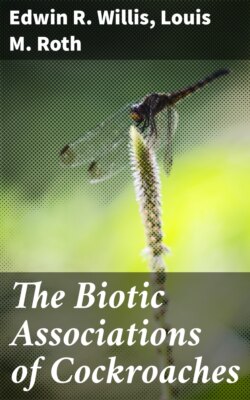Читать книгу The Biotic Associations of Cockroaches - Edwin R. Willis - Страница 123
На сайте Литреса книга снята с продажи.
OUTDOOR HABITATS
ОглавлениеTable of Contents
This category is a catchall for all cockroaches that are not limited to the more circumscribed habitats that have been previously considered. Some cockroaches in this section select specific microhabitats (e.g., Cryptocercus spp., which live exclusively in rotten logs; and Neoblattella dryas, N. eurydice, and N. grossbecki in bromeliads). Others are found in a wide variety of habitats (e.g., Ischnoptera deropeltiformis and Parcoblatta spp.). But some species are so little known that their actual habitats are barely suggested in the collection data.
Williams (1941) made an ecological study of the floor fauna of the Panama rain forest. He found Orthoptera (nearly all were unidentified nymphal cockroaches) in the litter of dead leaves, twigs, and other plant products in over 90 percent of the quadrats he examined. These insects represented about 0.25 percent of the total animal population.
Delamare Deboutteville (1948) made a quantitative study of the animal population in suspended soil that had accumulated between the roots of forest epiphytes of the lower Ivory Coast. He analyzed 2 dm.3 samples of soil from an epiphyte located 45 meters above ground on a main branch of Parinarium, with these results: Horizon A.—Superficial zone of large rootlets, 6 cm. deep: 2 cockroaches, 4 arachnids, and 4 beetles. Horizon B.—Zone of fine rootlets, 6 cm. deep: 6 cockroaches and numerous other arthropods. Horizon C.—Humid zone, 8 cm. deep: 7 cockroaches and numerous other arthropods. Plants, such as Palissota, were also living in this very original biotype.
The species of cockroaches listed below have been found in the following kinds of outdoor microhabitats: In jungle, forest, and woodlands they have been found in rotten wood; under bark of living, dead, and fallen trees; in decay cavities in trees; burrowing in living bark; on foliage of trees, shrubs, bushes, and low herbage; on vines and in bromeliads and epiphytic ferns; under signs on trees and stumps; in piles of logs and firewood; under dead leaves and debris; in and under decaying fruit on the ground. Cockroaches have been found between the leaves and under leaf sheaths of sugarcane, corn, and other grasses; under dry fibers and fronds of coconut trees; in hollow stems and bases of tree-fern fronds; under bracts of banana blossoms and in bunches of bananas (p. 146). Cockroaches also inhabit abandoned cocoons and larval tents, wasp nests, ant nests, termite nests, bird nests, rat nests, and burrows of other rodents (pp. 23-25, 310-319). Cockroaches have been found in rock crevices and under rocks; under boards and other objects on ground; under seaweed, drift, and other debris on beaches; burrowing in soil and under clods of earth; in marshes and swamps; in dumps and rubbish heaps.
The above list does not exhaust the available outdoor microhabitats that cockroaches find suitable for their continued existence, but it is fairly representative. Although we have no measurements to substantiate this conclusion, we suggest that the microhabitats cited above have a more constant temperature and a relatively higher humidity than is provided by the surrounding macrohabitats. We would expect insects such as cockroaches, whose water balance is dependent on a continuous supply of fluid water or moist food, to seek moist environments or to avoid situations in which their transpiration might increase. Deviations, presumably brief, from this expected behavior must occur to account for the cockroaches that are found under relatively unfavorable environmental conditions. Despite the apparent preference for cryptic habitats, some cockroaches are found in hot sunlight (Ellipsidion spp.; Tepper, 1893); Rehn (1945) has stated that many kinds are diurnal rather than nocturnal. Movement of cockroaches between habitats may be assumed to occur; but movement from an unfavorable environment to a more favorable one, following a shift in water balance, has not been observed in nature; however, laboratory experiments suggest that the mechanism for mediating such behavior is present in some species of cockroaches (Gunn and Cosway, 1938; Roth and Willis, 1952a). Obviously, additional research is needed on the bionomics of all species. Further conclusions based on current limited knowledge can only be speculative and possibly misleading.
